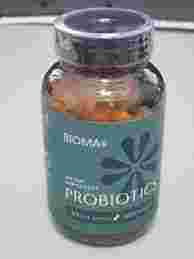What Are Probiotics?
Probiotics are defined (by FAO/WHO) as live microorganisms, which when administered in adequate amounts confer a health benefit on the host.
In practice, probiotic supplements aim to introduce or augment beneficial gut microbes, or at least support their growth. The idea is that some microbes may help:
- Compete with pathogenic or harmful bacteria
- Strengthen the intestinal lining / barrier
- Modulate immune responses
- Produce beneficial metabolites (e.g. SCFAs: acetate, propionate, butyrate)
- Influence gut motility or local inflammation
Many studies (in vitro, animal, human) have explored mechanisms by which probiotics might act, including modulation of immune pathways (e.g. NF-κB), enhancement of mucin production, competition for adhesion to gut epithelial surfaces, etc.
Prebiotics and Synbiotics
Prebiotics are non-digestible substances (typically fibers or oligosaccharides) that selectively feed beneficial gut bacteria, encouraging their growth or activity. Common prebiotics include inulin, fructo-oligosaccharides (FOS), galacto-oligosaccharides (GOS), and xylo-oligosaccharides (XOS).
A synbiotic combines probiotics + prebiotics in one formulation, often chosen so that the prebiotic component helps the probiotic strains thrive.
SCFAs (Short-Chain Fatty Acids)
One of the key beneficial outcomes associated with probiotic activity is the generation of SCFAs (particularly butyrate). Butyrate is a key fuel for colonocytes (cells lining the colon), helps maintain gut barrier integrity, and has anti-inflammatory effects. Some probiotic formulations (or associated ingredients) aim to increase butyrate levels or support butyrate-producing microbes.
The inclusion of tributyrin in Bioma is presumably intended to deliver or stimulate butyrate production.
Limitations and Real-World Challenges
While the promise of probiotics is strong, there are caveats:
- Not all strains have the same effects; benefits are often strain-specific
- Many supplements make broad claims without rigorous human clinical trials
- Survival of probiotic strains through the acidic gastric environment, and successful “engraftment” in the gut is variable
- Effects may differ between individuals, depending on the existing microbiome, diet, health status
- Regulatory oversight is often limited (in many countries, probiotic supplements are not subject to the same scrutiny as drugs)
- Some benefits observed in animal or small human trials may not translate to large, long-term, high-quality human trials
Thus, assessing a product like Bioma requires looking at what evidence exists for similar strains and metabolites — and whether the product offers something novel.
Ingredient Analysis: Bioma’s Key Components
Below is a closer look at the components typically cited in Bioma and how strong is the supporting science:
While each of these components has some supportive probiotics For Women scientific basis, the crucial question is whether Bioma’s formulation (combination, dose, delivery) leads to clinically meaningful effects in real people.
Claims vs. Evidence: What Does Bioma Promise, and How Much Is Backed?
Let us examine the key claims made by Bioma and assess how realistic they are, based on existing evidence.
1. Gut Health / Digestion / Bloating
One of the more plausible and moderate claims is improvement in digestion, relief of bloating, and better regularity. Many probiotic and synbiotic formulations report modest improvements in symptoms like gas, bloating, mild constipation, especially in cases of dysbiosis or irritable bowel syndrome (IBS).
If Bioma’s strains survive transit, colonize (even transiently), and interact with the gut ecosystem, such a benefit is possible — assuming the dose and formulation are suitable.
However, I could not find peer-reviewed clinical trials specifically on “Bioma Probiotics” in independent journals (as of my searches). The published sources appear to be promotional, press releases, or reviews rather than controlled randomized trials.
Thus, while the claim is biologically plausible, strong, independent clinical confirmation is lacking (at least publicly available) for this specific product.
2. Weight Loss / Metabolism / Craving Reduction
Bioma markets itself strongly for weight management, claiming that its gut-modulating approach can reduce cravings, block fat storage, and help metabolism.
This is a more ambitious claim and requires careful scrutiny. The connection between the gut microbiome and obesity/metabolism is a lively area of research; several studies suggest that differences in gut microbiota composition are associated with differences in body weight, insulin sensitivity, and energy harvesting.
However:
- Many of those studies are observational or animal-based, not definitive proof of causation
- Translating microbiome modulation into consistent and clinically meaningful weight loss in humans is challenging
- The effect sizes in published probiotic interventions for weight loss are often small, inconsistent, and sometimes not sustained
- If Bioma makes strong claims of “burning fat while you sleep” or “curbing cravings” as standalone effects, those should be viewed with caution in absence of robust human trials.
3. Immune Support and General Wellness
Because the gut is tightly linked to the immune system, many probiotic products (including Bioma) claim to boost immunity, reduce inflammation, etc. Theoretically, certain probiotic strains can modulate immune factors (cytokines, gut barrier integrity, local inflammation).
Again, this is plausible but depends heavily on strain, dose, duration, and individual variation.
Official Website> https://finance.yahoo.com/news/bioma-probiotics-officially-launches-revolutionary-192800618.html
visit here > https://www.globenewswire.com/news-release/2025/06/23/3103782/0/en/Bioma-Probiotics-Officially-Launches-A-Revolutionary-Step-Toward-Total-Gut-Health.htmlInbox




